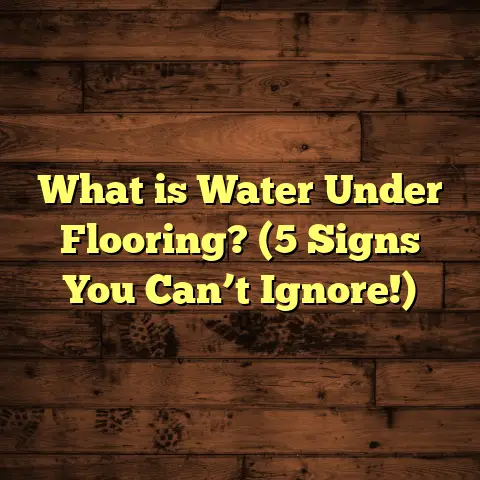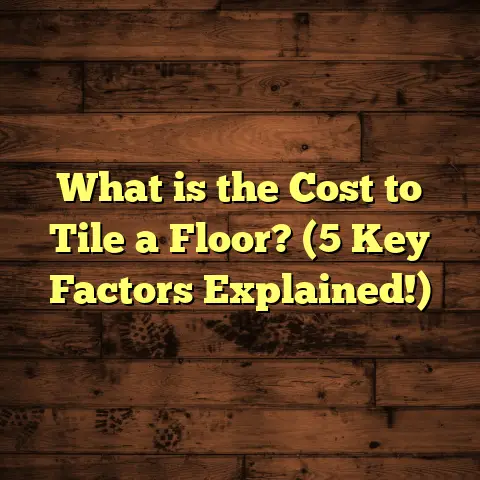What is Under Flooring? (5 Essential Benefits You Must Know)
Imagine you’ve just bought a new home or decided to remodel a room. You’re standing in that empty space, staring down at the floor, and wondering what comes next. You know you want a floor that looks great and feels good underfoot, but how much do you really know about what lies beneath the surface? I’ve spent years working with flooring systems, and I can tell you: the layers underneath your visible floor matter just as much—if not more—than the top material itself. Understanding under flooring can save you money, stress, and disappointment down the line.
What Is Under Flooring?
When most people think about floors, they picture hardwood, tile, laminate, or carpet. But there’s a whole world beneath those surfaces. Under flooring refers to all the materials and layers installed beneath the final flooring surface. These components create the foundation that supports your floor’s structure, controls moisture, cushions your steps, reduces noise, and helps extend the life of your flooring.
Let me break it down for you:
- Subfloor: This is the structural base layer attached directly to your home’s floor joists. It’s usually made from plywood, oriented strand board (OSB), or sometimes concrete slabs in basements.
- Underlayment: A thinner layer installed over the subfloor to smooth out imperfections, provide cushioning, or add moisture protection.
- Moisture or Vapor Barriers: Materials such as plastic sheeting installed to block moisture from seeping into floor layers.
- Soundproofing Pads: Specialized mats or materials designed to reduce impact sound and foot traffic noise.
These elements work together to ensure your top flooring material performs well over time. Skipping or neglecting these layers can lead to squeaks, warping, cracking, or premature failure.
The Foundation You Don’t See
Think about building a house. You wouldn’t skip pouring a strong foundation because you only care about how the walls look, right? Floors work the same way. The “foundation” under your floor surface is just as critical.
In my early days as a flooring installer, I saw so many projects where people chose expensive hardwood floors but ignored or rushed through subfloor repairs and underlayment installation. The floors looked fantastic at first but soon developed issues like gaps, loose boards, and buckling.
The lesson? A well-prepared underfloor system is the difference between a floor that lasts 10 years and one that stays strong for decades.
Why Should You Care About Under Flooring?
Maybe you think it’s just extra cost or hassle. But the truth is under flooring:
- Protects your investment
- Adds comfort and warmth
- Keeps your home quiet
- Guards against moisture damage
- Prevents structural problems
If these sound important to you—and they should—you’ll want to get familiar with what goes into under flooring and why it matters.
1. Structural Stability: The Backbone of Your Floor
Without a solid base beneath your floor covering, nothing else matters. The subfloor is the main support layer attached directly to your home’s joists or slab. Its job is to hold everything steady and carry weight evenly.
A typical wood-frame home uses plywood or OSB sheets for subflooring. These sheets are usually 3/4 inch thick and are fastened securely with nails or screws to prevent movement.
Why does thickness and fastening matter? Because if the subfloor is too thin or loosely attached, it will flex every time you walk on it. This flexing causes creaking sounds, weak spots, and can lead to cracks or gaps in your finish flooring.
I remember a project where the homeowner complained about squeaky hardwood floors. After inspection, I found nails had popped loose from an improperly fastened subfloor. We replaced the subfloor with thicker plywood secured with ring-shank nails spaced every 6 inches along joists. The squeaks disappeared completely.
Subfloor Standards and Spacing
Most building codes recommend joist spacing of 16 inches on center for residential floors. If joists are spaced wider—like 24 inches—the subfloor needs to be thicker or reinforced to prevent sagging.
The stiffness of your subfloor directly affects how well your finished floor performs. Studies by the APA – The Engineered Wood Association show that floors built with 3/4 inch plywood over 16-inch joist spacing have 25% less deflection (bending) than thinner sheets over wider spacing.
Concrete Slabs: A Different Story
If you have a basement or slab-on-grade foundation, your “subfloor” might be a concrete slab. Concrete is strong but can be cold and prone to moisture issues. That’s why additional underlayment layers become even more critical in these cases.
2. Moisture Protection: Your Floor’s Shield Against Damage
Moisture is one of the biggest enemies of floors, especially wood-based ones. It can cause swelling, warping, mold growth, and even structural damage.
Under flooring systems often include moisture barriers—materials designed to block water vapor from rising through concrete slabs or seeping from below grade.
Why Is Moisture Such a Problem?
Wood is hygroscopic—it absorbs moisture from its environment. When wood flooring takes on too much moisture:
- It swells and expands
- Joints can open up
- Boards may cup or buckle
- Mold and mildew can grow underneath
Laminate and engineered wood floors have some tolerance but still require protection from moisture vapor transmission.
Types of Moisture Barriers
- Polyethylene Sheeting: This is a plastic film typically 6 mil thick placed between concrete slabs and subfloor layers.
- Foam Underlayments with Vapor Barrier: Some foam pads come with built-in vapor barriers.
- Liquid Moisture Barriers: Applied as sealants on concrete slabs before flooring installation.
- Silica-Based Barriers: Specialty products that block moisture while allowing vapor diffusion.
Data on Moisture Vapor Transmission
According to research from the U.S. Department of Energy and NWFA:
- Moisture vapor transmission rates above 3 pounds per 1,000 square feet per 24 hours can damage wood floors.
- Installing a polyethylene vapor barrier reduces vapor transmission by up to 90%.
- Moisture-related flooring failures account for nearly 40% of all installation callbacks in humid climates.
My Experience with Moisture Issues
One humid-climate client had persistent mold odors beneath their carpeted floors despite regular cleaning. After testing moisture levels in their concrete slab foundation, I recommended installing a vapor barrier and switching to vinyl plank flooring with additional waterproof underlayment.
Six months later? No mold smell, no floor damage—and very happy homeowners who appreciated how much better the space felt.
3. Comfort: Walk Softly and Warmly
Have you ever stepped barefoot onto a hard tile or concrete floor and wished it was warmer? That’s where under flooring makes a real difference in comfort.
Many underlayments provide cushioning that softens each step and adds insulation to keep floors warm in colder months.
Types of Underlayment for Comfort
- Foam Underlayments: Lightweight pads commonly used under laminate or engineered wood floors.
- Cork Underlayments: Natural material offering excellent cushioning plus thermal insulation.
- Rubber Pads: Used primarily for soundproofing but also add softness.
- Felt Underlayments: Thick fiber pads used mainly under carpet for plushness.
Energy Efficiency Benefits
Adding an insulating underlayment can reduce heat loss through floors by up to 15%, according to data from energy-efficient housing studies by the Building Science Corporation.
In cold climates, this translates into lower heating bills and more comfortable living spaces during winter months.
How I Helped Clients Improve Comfort
I worked on a home renovation in northern Minnesota where the family was frustrated with cold floors during winter. We installed cork underlayment beneath their hardwood floors.
They called me back months later raving about how much warmer their feet felt—and how their heating bills dropped noticeably thanks to better insulation at the floor level.
4. Soundproofing: Silence Is Golden
Noise travels surprisingly well through hard floors. If you live in apartments or multi-story homes, footsteps from above can be maddening.
Under flooring soundproofing layers absorb impact noise so it doesn’t echo through your home.
How Does It Work?
Soundproofing underlayments reduce vibration caused by footsteps or moving furniture. They convert kinetic energy into heat or dampen sound waves before they pass through ceiling structures below.
Materials used include:
- Rubber mats: Dense pads with excellent sound absorption.
- Fiberboard underlayments: Made from wood fibers compressed into sheets.
- Cork: Naturally sound absorbing.
- Foam pads with soundproofing additives
Measurable Impact on Noise Levels
According to ASTM testing standards:
- High-density rubber underlayments can reduce impact noise by up to 50 decibels.
- Fiberboard pads reduce airborne sound transmission by up to 20 dB.
- Combining multiple layers (e.g., rubber + plywood subfloor) increases overall sound reduction.
Real-life Success Stories
I installed soundproofing underlayment in a condo where neighbors complained about loud footsteps above them. After adding a dense rubber pad beneath laminate flooring, complaints stopped within weeks.
Clients often tell me that quieter floors improve their quality of life dramatically—especially in busy households with kids or pets running around all day.
5. Prolonging Floor Life: Protect Your Investment
Floors aren’t cheap. Hardwood planks, luxury vinyl tiles (LVT), or engineered woods all cost hundreds or thousands of dollars depending on size and quality.
Proper under flooring helps protect your investment by creating a stable environment for your top layer, reducing wear and tear over time.
How Under Flooring Protects Finishes
Uneven subfloors or missing underlayment can cause:
- Cracks in laminate boards
- Cupping or warping in hardwood floors due to moisture wicking
- Tile cracking due to lack of support underneath
- Premature carpet wear where padding is thin or missing
Underlayment evens out minor imperfections like bumps or gaps in subfloors so finishes don’t flex excessively.
Industry Data on Longevity
Research by the Flooring Industry Association shows:
- Floors installed with proper underlayment last on average 25% longer before needing refinishing or replacement.
- Warranty claims drop significantly when moisture barriers and cushioning layers are included.
- Proper installation reduces callbacks and repair costs by up to 40%.
My Observations Over Years
I’ve seen first-hand how skipping these layers leads to costly repairs within just a few years. Conversely, floors installed carefully over quality underlayment systems continue looking new long after typical warranty periods expire.
One client’s hardwood floor had minor cupping caused by moisture from below their slab foundation. Adding an effective vapor barrier during repairs prevented recurrence for years afterward.
Diving Deeper: Types of Subfloors and Underlayments Explained
Now that you know why under flooring matters so much, let me share some practical details about materials I’ve worked with extensively:
Subfloor Materials
| Material | Pros | Cons | Typical Use |
|---|---|---|---|
| Plywood | Strong, stable, widely available | Can delaminate if wet | Most residential wood-frame homes |
| OSB (Oriented Strand Board) | Cost-effective, uniform thickness | More prone to swelling if exposed to water | Alternative to plywood |
| Concrete Slab | Very durable; good for basements | Cold; prone to moisture without barriers | Basements; slab-on-grade foundations |
Underlayment Materials
| Material | Benefits | Drawbacks | Common Applications |
|---|---|---|---|
| Foam Pads | Affordable; cushion; lightweight | Can compress over time | Laminate; engineered wood |
| Cork | Natural; excellent thermal & sound insulation | Higher cost | Hardwood; luxury vinyl |
| Rubber Mats | Superior soundproofing; durable | More expensive | Apartments; condos; commercial |
| Felt | Soft cushioning | Less moisture resistance | Carpet padding |
| Vapor Barrier Sheets | Essential for moisture control | Requires proper installation | Over concrete slabs |
I always tailor my recommendations based on your floor type, climate conditions, and home structure.
How To Choose The Right Under Flooring For Your Project?
Selecting the right materials depends on several factors:
- Type of Finished Flooring
- Hardwood requires flat, dry surfaces with vapor barrier if over concrete.
- Laminate needs cushioning foam over smooth subfloors.
- Tile demands rigid subfloors with little flexibility.
- Carpet benefits from thick felt padding for softness.
- Moisture Conditions
- Basements or slab-on-grade require vapor barriers.
- Humid climates call for moisture-resistant underlayments.
- Sound Concerns
- Multi-story buildings usually benefit from soundproofing layers.
- Budget
- Quality underlayment doesn’t have to break the bank but cutting corners here often costs more later.
- Installation Method
- Floating floors need specific foam pads.
- Glue-down tiles require compatible adhesives and substrates.
Common Mistakes I’ve Seen (And How To Avoid Them)
After years on job sites and thousands of customer consultations, I want to share some pitfalls I see all too often:
- Skipping Vapor Barriers Over Concrete: Leads to mold growth & floor warping.
- Ignoring Subfloor Repairs: Weak spots cause creaking & damage finish flooring.
- Choosing Incompatible Underlayment: Not all pads work with all floor types.
- Poor Fastening of Subfloor: Nails popping out cause squeaks & instability.
- Not Testing Moisture Levels Before Installation: Surprises that ruin floors quickly.
Avoiding these saves time, money, and headaches later on.
Custom Case Study: From Problem Floor to Perfect Finish
A couple contacted me after their new laminate floor started separating just three months post-installation in their basement apartment.
I inspected their setup:
- No vapor barrier beneath laminate
- Concrete slab was damp
- Subfloor was uneven OSB panels
- Cheap foam underlayment compressed unevenly
What did we do?
- Removed laminate
- Installed polyethylene vapor barrier taped at seams
- Added treated plywood subfloor panels screwed tightly over slab
- Laid high-quality foam pad designed for basements
- Reinstalled laminate planks carefully following manufacturer guidelines
Result? Zero issues six months later—and they were thrilled with their dry, stable floor that looked brand new.
This story highlights why every step matters when it comes to under flooring preparation.
The Role of Technology: Tools Like FloorTally for Planning Your Project
Estimating costs and choosing materials can get confusing quickly—especially if you’re doing this yourself (DIY) or managing contractors remotely.
That’s where tools like FloorTally come in handy:
- They give precise cost estimates based on local prices for materials & labor.
- Offer customizable options so you can try out different materials & textures virtually.
- Incorporate waste factors so you buy enough materials without overspending.
- Provide clear visualization of total project costs helping budgeting decisions.
I recommend using such platforms early in your planning process to avoid surprises down the line.
Wrapping Up My Thoughts on Under Flooring Benefits
To sum it up—here are the five essential benefits of paying attention to what goes underneath your floor surface:
1. Stability: Keeps your entire floor structure solid and squeak-free
2. Moisture Protection: Stops water damage & mold growth before it starts
3. Comfort: Adds softness & warmth for happier feet
4. Soundproofing: Keeps your home quieter & cozier
5. Durability: Helps floors look better longer & reduces repair needs
If you’re serious about a dependable floor that feels great every day—and lasts decades—I encourage you not to overlook these hidden layers beneath your feet. Ask questions about subfloors, moisture control measures, suitable underlayments—and don’t hesitate to get professional advice if needed.
From my experience working across diverse homes and climates, investing time in proper under flooring preparation pays off immensely both financially and in peace-of-mind comfort.
Interested in learning which specific underlayment would suit your project best? Or maybe how different climate zones affect these choices? Just let me know—I’m happy to share tailored advice based on years of experience!





